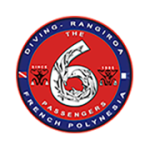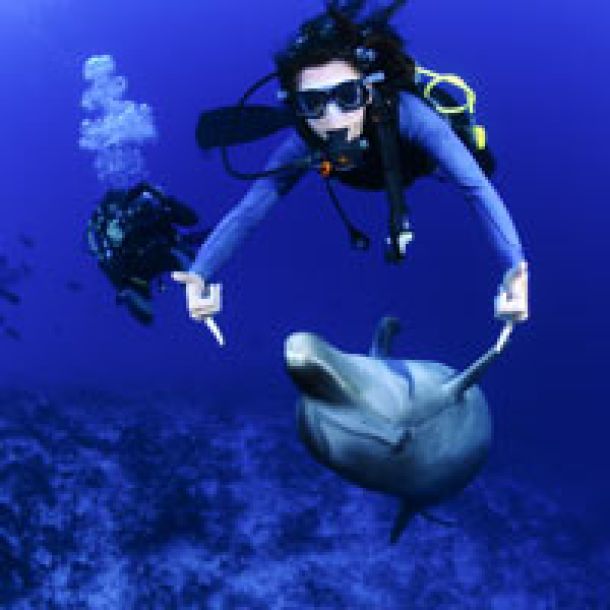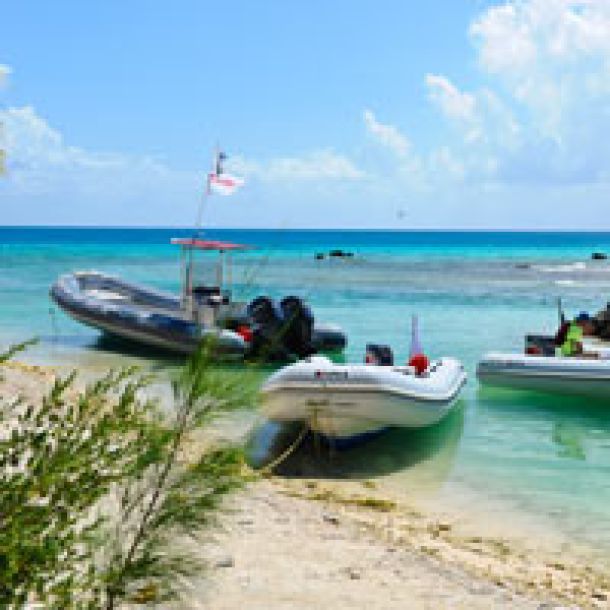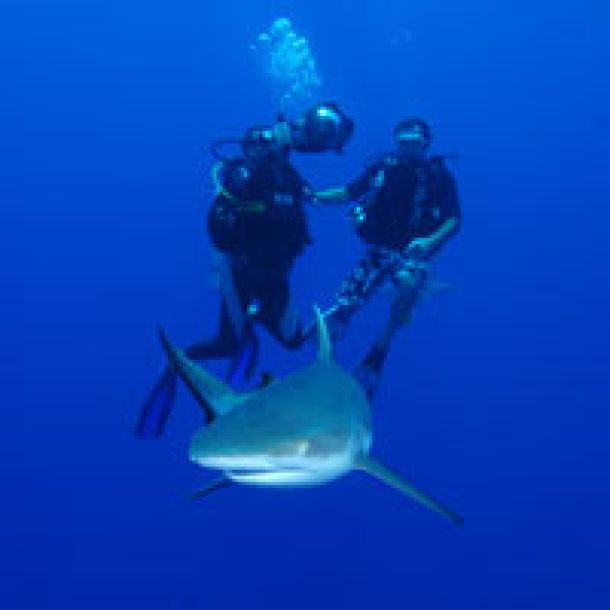Tiputa Pass
Inward & outward
flowing current
Tiputa Pass
(inward current)
The Sharks' cavern
This dive, starting at the right angle right out of the pass can be considered as accessible to all levels although recommended to experienced divers for it requires that you be well-balanced and feel like a fish in water. The cavern owes its name to a cavity down at 115 feet. Against every expectation, there are no sharks in it and divers actually have to stay in the cavern so that gray reef sharks come as close to us as possible. To put it clearly, the sharks are those who are afraid of us and we must stay quiet and idling if we want sharks to fight their natural fear and then come closer to us. After a ten minute stay there we will plunge from the angle into the pass and the current will lead us into the interior of the lagoon... Said that way sounds easy...And it actually is! What's more, it is truly exciting to drift like that in the current and virtually fly in the water without stroking with your fins...The greatest difficulty of this dive is to remain regrouped and not stray away so for that, the simplest thing is to stay behind the instructor, at the same depth as his and to never lag behind for whatever reason. During the drifting in the pass we will glance at little grottos, full of colors and little animals. Towards the end of the diving we will slither in the calm waters of the lagoon in which we will decompress slowly and in all safety. Even though level 1 divers cannot reach the cavern at 115 feet deep, we can tell you that you will get a lot of fun and emotions.
The Canyons
The first part of the diving is similar to the latter but once in the pass, roughly half-way, we will swerve to the middle of the pass and stop at every canyon – hence the name of this dive – The canyons cross the pass in its width. This dive is intended for more experienced divers because, except a few times, we are right in the middle of the pass where the current is the strongest. The dive is particularly nice in June, during the reproduction time of gray reef sharks. They gather by hundreds in the canyons and you can even watch some big S. Mokarran, those great hammerhead sharks!
The Step
This dive is for the most experienced divers. It starts in the ocean, smack dab at the mouth of the pass. One can do it in January, February and March during the great hammerhead shark season, the S. Mokarran season, at between 148 feet and 180 feet deep. At this time of the year, there are often great schools of stingrays seeking for unison to challenge the attacks of starving great hammerheads. "There are so many of us so why choose me specially?!" The dive ends in the interior of the lagoon too.
The Crossing
This is a dive perfect for the most experienced divers. It starts in deep blue waters off the right angle of the pass' entrance. So, as the name of the dive suggests it, the main purpose of this dive is to do the crossing of the pass with the inward flowing current from one side to the other. You need to stay quite deep below because the current is actually always much stronger at the surface. There are some 164 feet below surface at the deepest and it can be said that this is the best opportunity to watch schools of gray reef sharks. Once you have crossed the pass you will find yourself roughly at the sharks' cavern. From there, we will begin drifting with the current into the lagoon.
All dives are located on the right ocean-side slope of the pass
The windmill
The dive starts on the oceanic reef slope at about 383 yards from the angle of the pass' entrance, far from the outward flowing current and drawing close the angle, which is the opening of the pass too. During the diving the reef is on the left-hand side and the blue on the right-hand side. Maximum depth is 82 to 85 feet. This dive is open to any certified diver and is the occasion to encounter wonderful species like dolphins, manta rays, stingrays, tuna, humphead wrasses, sea turtles...
The BLUE
The dive starts at the same point as the Windmill but we will be swimming at 328 yards from the reef slope. Right in the blue with an average of 820 feet below our fins. The main purpose of this dive is to meet with Albimarginatus in the blue and, with a stroke of luck, with nice silky sharks. We will be diving down to 50 feet and once the group of divers has all stabilized at the same depth we wait for our friends. They won't be long to come up and praise the intrepid photographers! We will stay there about 15 minutes before coming back towards the reef to end the dive just like the end of the Windmill, all in maximum safety.
The half-Windmill
This is a 160 yard away dive from the entrance of the pass and away from the outward flowing current too. The proximity of the pass allows for a game of counter-currents and to make it possible to get into the pass and go alongside the reef, and see all the little life-sprawling grottos on the way. Please remind that this dive is open to any certified diver and one can enjoy the same encounters that the other dives above, all in colors.
The Angle
As the name suggests it, this dive starts right near the angle of the pass. This dive is open to any certified diver and is ideal to make great discoveries even if this is even greater for more experienced divers for whom the main purpose will be to go down to the bottom at around 150 feet to observe the frequent coming and going of some mantas, a squadron of gray reef sharks, stingrays flying by or simply schools of yellow ludjans or even a big hammerhead shark. All of that depending on the moment and the season. Knowing that level 1 certified divers cannot reach this depth, they can stop at 80 feet and have a breathtaking overview of it and even get lost in a dazzling school of striped barracudas.
Avatoru Pass
Inward & outward
flowing current
Avatoru Pass
(inward current)
The small pass
For experienced divers particularly. The Avatoru pass breaks into two channels separated by a little islet at the entrance of the lagoon. The one on the left, quiet wide and not really interesting from a scuba diving point of view and the one on the right, much smaller and rightfully dubbed the little pass. Our dive starts roughly in the middle of the pass on the right side when looking towards the lagoon and we then drift in the current into the narrowest part of the pass. The difficulty is not so much about the depth but rather about the fairly strong unsteady current – in general, the stream is always stronger in a narrow passage than in a wide one, given that the quantity of water that must go through in the same space of time is still the same. The purpose of this dive is to see the wonderful little grottos open in the very flank of the reef, especially when entering the lagoon.
This is undoubtedly the most colorful dive experience, watching manta rays feeding themselves against the current and white tip sharks resting and quietly getting oxygen in the grottos. The dive ends in the calm waters of the lagoon.
This is undoubtedly the most colorful dive experience, watching manta rays feeding themselves against the current and white tip sharks resting and quietly getting oxygen in the grottos. The dive ends in the calm waters of the lagoon.
Avatoru Pass (outward current)
Avatoru right side
For all levels. The dive starts on the ocean-side reef slope some 160 yards away from the right angle of the pass, when looking towards the ocean. There are two curiosities: The big white tip reef sharks (C.Albimarginatus) and a large school of horse eye jackfish. The Avatoru pass is less deep than the Tiputa one and is oriented slightly differently from the flowing current, which means that we can thus enter the pass much more easily in spite of the outward flowing current.
Our diving session will consist of making a big circle around and right at the pass to finish almost at the ocean-side reef slope with the outward flowing current in all safety.
Our diving session will consist of making a big circle around and right at the pass to finish almost at the ocean-side reef slope with the outward flowing current in all safety.
The 6 Passengers
First-time dives and training
The Tiputa pass, just like the Avatoru pass, is separated by an islet close to the lagoon. It is there, on one of the sides away from the current that we do these dives, on the site dubbed the Aquarium.
The different dives in Rangiroa
On top you can see the description of all the different dives in Rangiroa. As we already said, we have only a few scuba diving sites but these dives are considered rightly as exploration dives because one dive does never look like another due to the incredible fauna and all the varied species and the possible causalities of the fascinating animal world.
The 6 Passengers
Schedule
07:45 am | Pick-up at any guest house or hotel in the Avatoru district |
08:00 am | Preparing the equipment & briefing |
08:15 am | Loading equipment on the boat and departure for diving |
08:20 am | DIVING |
09:45 am | Back from diving & watching of the dive on HD wide screen |
10:00 am | Preparing the equipment & briefing (first-time dive & training dive) |
10:30 am | DIVING |
11:45 am | Back from dive and debriefing |
12:45 - 01:45 pm | Lunch |
01:45 pm | Pick-up at any guest house or hotel in the Avatoru district |
02:00 pm | Loading equipment on the boat and departure for diving |
02:20 pm | DIVING |
03:45 pm | Back from diving & watching of the dive on HD wide screen |
04:00 pm | Preparing the equipment & briefing (Training dive) |
04:30 pm | DIVING |
05:45 pm | Back from diving & Debriefing |
06:30 pm | End of the day |
The 6 Passengers
Safety
There is very little danger if one dutifully pays attention to the enlightening briefing of the instructor! Nevertheless, your safety remains a constant priority.
Every boat is equipped with Oxygenotherapy devices, first aid kit, and VHF radio permanently connected to the center.
The entire equipment is checked monthly. On Tahiti island, there is a modern recompression chamber facility and competent hyperbaric doctors.
All of our instructors have French-state certification and are fully trained for the diving conditions of Rangiroa’s passes.
Now about sharks, remember that you make it scarier than you are.
Last but not least, and to stay out of any potential danger, we recommend that you may not touch anything when diving. By gazing at them only, we respect the marine environment and its animals, preserving them while protecting ourselves too.
Every boat is equipped with Oxygenotherapy devices, first aid kit, and VHF radio permanently connected to the center.
The entire equipment is checked monthly. On Tahiti island, there is a modern recompression chamber facility and competent hyperbaric doctors.
All of our instructors have French-state certification and are fully trained for the diving conditions of Rangiroa’s passes.
What are the dangers of scuba diving in Rangiroa?
There are no sea snakes in Polynesia and the most poisonous fish is the stonefish - Synaceia verrucosa and some species of red lionfish – of the Scorpaenidae family. Some other species of seashells, the Conus seashell can be very hazardous for man unless you firmly grab it up.Now about sharks, remember that you make it scarier than you are.
Last but not least, and to stay out of any potential danger, we recommend that you may not touch anything when diving. By gazing at them only, we respect the marine environment and its animals, preserving them while protecting ourselves too.
Regulation in French Polynesia
The scuba diving regulation system is particularly severe. The rules governing this field of activity are of prime importance and flouting them may result in heavy consequences as much for the instructors as for the scuba diving center in which they work.
Clients are particularly interested in regulation concerning assistance at different depths depending on their own certification.
First and foremost, keep in mind that this is a French territory, which means that the CMAS system applies, which is what we refer to. But it does not mean that other schools are not accepted or even recognized – the center is even a PADI resort – but other certification titles are considered by the CMAS as equivalents only.
The equivalence principle implies that all level 1 and level 2 certifications from any other school will be considered as level 1 CMAS and that divers can get assistance down to a maximum depth of 95 feet – for instance, an Open Water PADI certificate and an Advanced Open Water PADI certificate will be considered as equivalent regarding the maximum depth.
Level 3 and level 4 certificates other than the CMAS ones will be considered as a level 2 CMAS certificate and divers can get assistance down to a depth of 160 feet.
For any other certificate, the maximum depth will necessarily be 197 feet.
Clients are particularly interested in regulation concerning assistance at different depths depending on their own certification.
First and foremost, keep in mind that this is a French territory, which means that the CMAS system applies, which is what we refer to. But it does not mean that other schools are not accepted or even recognized – the center is even a PADI resort – but other certification titles are considered by the CMAS as equivalents only.
The equivalence principle implies that all level 1 and level 2 certifications from any other school will be considered as level 1 CMAS and that divers can get assistance down to a maximum depth of 95 feet – for instance, an Open Water PADI certificate and an Advanced Open Water PADI certificate will be considered as equivalent regarding the maximum depth.
Level 3 and level 4 certificates other than the CMAS ones will be considered as a level 2 CMAS certificate and divers can get assistance down to a depth of 160 feet.
For any other certificate, the maximum depth will necessarily be 197 feet.



